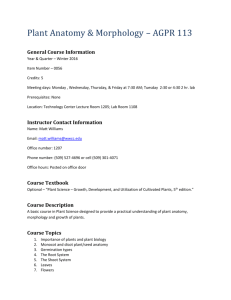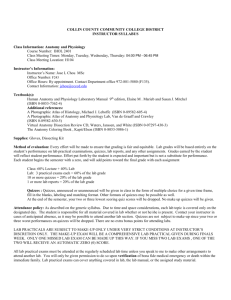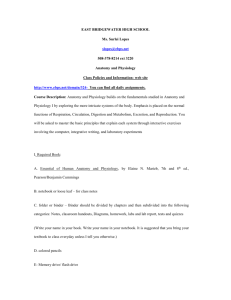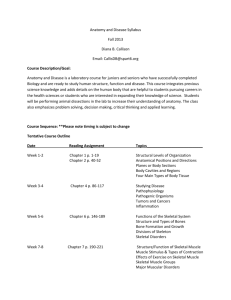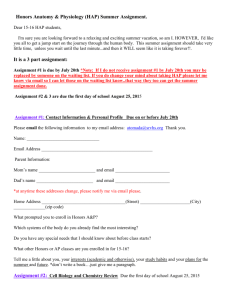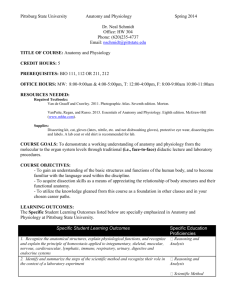Anatomy 1 - Spring 1999 - Los Angeles Mission College
advertisement
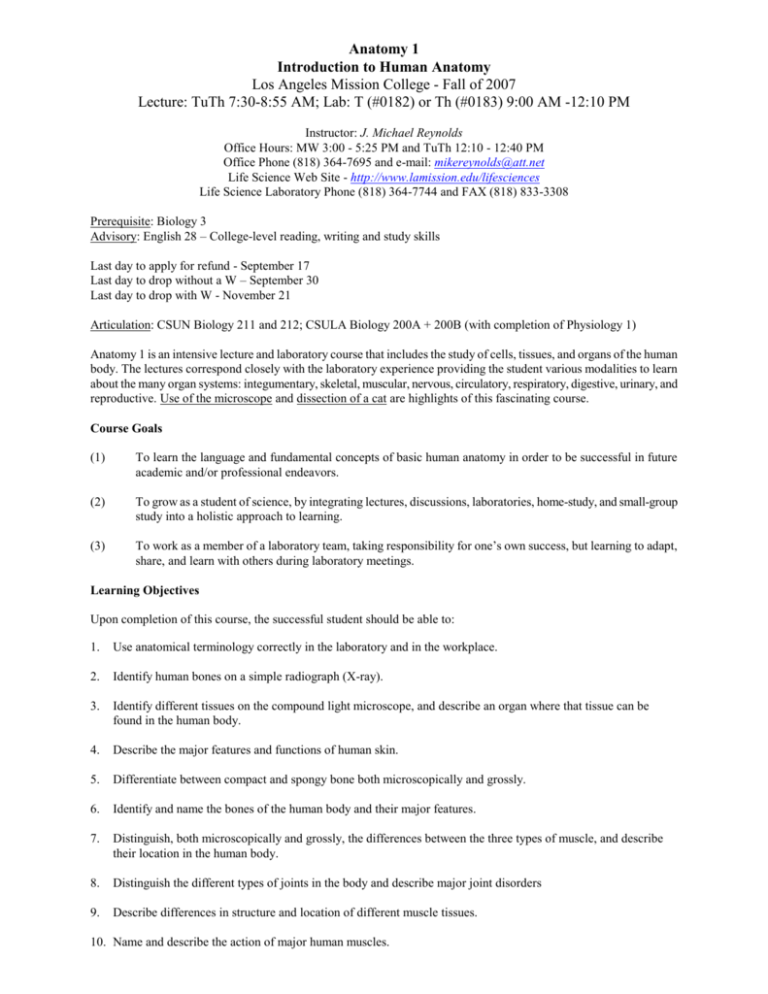
Anatomy 1 Introduction to Human Anatomy Los Angeles Mission College - Fall of 2007 Lecture: TuTh 7:30-8:55 AM; Lab: T (#0182) or Th (#0183) 9:00 AM -12:10 PM Instructor: J. Michael Reynolds Office Hours: MW 3:00 - 5:25 PM and TuTh 12:10 - 12:40 PM Office Phone (818) 364-7695 and e-mail: mikereynolds@att.net Life Science Web Site - http://www.lamission.edu/lifesciences Life Science Laboratory Phone (818) 364-7744 and FAX (818) 833-3308 Prerequisite: Biology 3 Advisory: English 28 – College-level reading, writing and study skills Last day to apply for refund - September 17 Last day to drop without a W – September 30 Last day to drop with W - November 21 Articulation: CSUN Biology 211 and 212; CSULA Biology 200A + 200B (with completion of Physiology 1) Anatomy 1 is an intensive lecture and laboratory course that includes the study of cells, tissues, and organs of the human body. The lectures correspond closely with the laboratory experience providing the student various modalities to learn about the many organ systems: integumentary, skeletal, muscular, nervous, circulatory, respiratory, digestive, urinary, and reproductive. Use of the microscope and dissection of a cat are highlights of this fascinating course. Course Goals (1) To learn the language and fundamental concepts of basic human anatomy in order to be successful in future academic and/or professional endeavors. (2) To grow as a student of science, by integrating lectures, discussions, laboratories, home-study, and small-group study into a holistic approach to learning. (3) To work as a member of a laboratory team, taking responsibility for one’s own success, but learning to adapt, share, and learn with others during laboratory meetings. Learning Objectives Upon completion of this course, the successful student should be able to: 1. Use anatomical terminology correctly in the laboratory and in the workplace. 2. Identify human bones on a simple radiograph (X-ray). 3. Identify different tissues on the compound light microscope, and describe an organ where that tissue can be found in the human body. 4. Describe the major features and functions of human skin. 5. Differentiate between compact and spongy bone both microscopically and grossly. 6. Identify and name the bones of the human body and their major features. 7. Distinguish, both microscopically and grossly, the differences between the three types of muscle, and describe their location in the human body. 8. Distinguish the different types of joints in the body and describe major joint disorders 9. Describe differences in structure and location of different muscle tissues. 10. Name and describe the action of major human muscles. 11. Draw the structure of a neuron and label its parts. 12. Name and describe the function of the major structures of the human brain. 13. Recite the twelve cranial nerves in numbered order (I-XII) and describe the role of each. 14. Describe the anatomical and functional differences between the dorsal and ventral roots of spinal nerves, and the dorsal and ventral horns of the grey matter of the spinal cord. 15. Describe the structure of an intervertebral disc. 16. Explain the anatomical and functional differences between the sympathetic and parasympathetic divisions of the autonomic nervous system. 17. Identify and name the structures of the human eye. 18. Identify and name the structures of the human ear. 19. Identify and name the glands of the endocrine system. 20. Describe the major similarities and differences in the structure of an artery and a vein. 21. Describe the flow of blood through the heart and identify all major vessels, chambers and valves. 22. Explain the purpose of the lymphatic system and identify the lymph vessels and nodes both histologically and anatomically. 23. Identify and name, histologically and anatomically, the major components of the respiratory system. 24. Identify and name, histologically and anatomically, the major components of the digestive system. 25. Identify and name, histologically and anatomically, the major components of the urinary system, and describe the differences between males and females. 26. Identify and name, histologically and anatomically, the major components of the reproductive systems of males and females. Books required: Human Anatomy and Physiology, Elaine N. Marieb and Katja Hoehn, 7th Edition, 2007 Human Anatomy and Physiology Lab Manual, Cat Version, Marieb and Mitchell, 9th Edition, 2007 suggested: a medical dictionary (e.g. Dorlund's pocket medical dictionary, depending on $$$ you want to spend) lecture notes: available from the Life Science main page at http://www.lamission.edu/lifesciences. Click on Lecture Notes, then select the section number of the course. Evaluation and Grading 1. Quizzes (10 points each) A quiz will be administered at the start of lecture on 8 different occasions during the semester (see schedule below). Quiz #1 will be given on Tuesday, September 11 at 7:30 AM (do not be late!!!). Each quiz will take approximately fifteen minutes and will emphasize material covered during previous class meetings. The quizzes are intended to stress the importance of staying up with the material! There will be a total of 8 quizzes worth 10 points each. At the end of the semester the lowest quiz score will be dropped and the average of the all quiz scores will be counted as Extra Credit. Quizzes cannot be made up!! Do not be late to class! 2. Laboratory Review Sheets and Lab Participation (approximately 15 X 8 = approximately 120 points) Students are required to complete and submit the Review Sheets (RS pages) in the back of the Lab Manual for all assigned laboratory exercises. Review Sheets must be returned at the beginning of the next laboratory meeting that is scheduled. The Review Sheets for each of the 15 laboratory meetings will be worth 8 points each. Do not underestimate the value of these points! Every semester some students lose a whole grade because of absence, tardies, failure to participate or failure to hand-in Review Sheets complete and on-time. Students are encouraged to work together to complete these review sheets, but simple copying is not suggested as a valuable way to review the material. 3. Objective Midterm Exams (3 X 100 = 300 points) There will be 3 objective midterm exams as shown on the class schedule. No make-up midterms will be given. A student who has an excused absence from one midterm only will have the percentage earned on the next examination counted for that missed score. 4. Lab Practical Midterm Exams (2 X 50 = 100 points) There will be 2 lab practical exams scheduled during Week 7 and Week 11. The practical exams will involve the “handson” identification and understanding of material presented in the laboratory exercises. 5. Final Lab Practical Exam (50 points) It will cover all material from all laboratory exercises throughout the semester and the last two weeks of the course. No make-up Final Lab Practical Exam will be given. Students should plan their schedule accordingly. 6. Final Objective Exam (100 points) One-half of the exam will be a midterm covering the final chapters and the other half will be cumulative representing the entire course. No make-up Final Exam will be given. Students must plan their schedule accordingly. GRADING SCALE: Percentage of Total Points 100 - 90 89 - 80 79 - 70 69 - 60 59 - lower Letter Grade A B C D not passing (F) Office Hours and Comments I will remain after class to answer questions and offer individual assistance. Appointments to meet at other times may be arranged. Do not be shy. I am here to help you learn and it is a pleasure for me to give extra help when requested. Do not fall behind! This is a fast-paced course that covers a lot of material in very few class meetings. It is incumbent upon each student to do the readings, participate actively in the lab, and study diligently at home. Do not fall behind! This is a fast-paced course that covers a lot of material in very few class meetings. It is incumbent upon each student to do the readings, participate actively in the lab, and study diligently at home. Do not fall behind! This is a fast-paced course that covers a lot of material in very few class meetings. It is incumbent upon each student to do the readings, participate actively in the lab, and study diligently at home. Do not fall behind! Did I say that enough times?????? Work together! It is phenomenal what two or more people can learn at a lab table working together compared to one lonely, lost soul trying to find a "fungiform papilla" on a tongue slide. Come to class prepared to help one another. Ask questions! There is no such thing as a stupid question. The chances are that if you don't know what is going on, 80% of the class is sitting there as ignorant as you, waiting for someone to ask. We have all been there before. So speak up! Read the assigned text before the lecture! Anatomy is a subject that is learned by repetition, repetition, repetition........... Reading and becoming familiar with the topic and the vocabulary will allow the lectures to help make “sense” of the text book and start you on the process of sinking the material into your gray matter! Additional Materials Each lab table is encouraged to bring dissection equipment for their own use, as much of the college equipment that is available is old and dull. Scan-Tron answer sheets will be required for Quizzes and Objective Examinations. Lecture/Laboratory Schedule Date Lecture/Laboratory Reading/Lab Exercise Week 1 Tu 9/4 Th 9/6 The Language of Anatomy Organ Systems Overview Intro to Course; Anatomical Terminology Medical Imaging; Organ Systems Overview Exercise 1 Exercise 2 and Rat Dissection Chapter 1 Chapter 1 Week 2 Tu 9/11 Th 9/13 Classification of Tissues Study of Tissues - Histology I Study of Tissues - Histology II Exercise 6A Chapter 4 Chapter 4 Week 3 Tu 9/18 Th 9/20 Integumentary System/Membranes Bone Classification: Overview Integumentary System Skeletal Tissue and Bone Overview Exercises 7 & 8 Exercise 9 Chapter 5 Chapter 6 Week 4 Tu 9/25 Th 9/27 Axial Skeleton OBJECTIVE MIDTERM EXAM #1 The Axial Skeleton I Exercise 10 Chapters 1, 4, 5, 6 and Labs 7: Part 1 – Axial Skeleton Week 5 Axial Skeleton Fetal Skeleton The Axial Skeleton II The Appendicular Skeleton Exercise 10 Exercise 12 7: Part 1 – Axial Skeleton 7: Part 2 – Appendicular Skeleton Quiz #3 Appendicular Skeleton Articulations and Body Movement Joints Muscle Tissue and Muscle Overview Exercises 11 Exercise 13 Chapter 8 Chapter 9 LAB PRACTICAL EXAM #1 Gross Anatomy of Muscular System Dissection #1 - Cat Muscles The Muscular System I The Muscular System II Exercises 1,2 and 6 - 13 Exercise 15 Gross Anatomy of Muscular System Dissection #1 - Cat Muscles The Muscular System III OBJECTIVE MIDTERM EXAM #2 Exercise 15 Gross Anatomy of Muscular System Dissection #1 - Cat Muscles Histology of Nervous Tissue Anatomy - Brain & Cranial Nerves Nervous Tissue & Cranial Nerves The Brain Exercise 15 Tu 10/2 Th 10/4 Week 6 Tu 10/9 Th 10/11 Week 7 Tu 10/16 Th 10/18 Week 8 Tu 10/23 Th 10/25 Week 9 Tu 10/30 Th 11/1 Chapter 10 Chapter 10 Chapter 10 Chapters 7, 8, 9, 10 Exercise 17 Exercise 19 Chapters 11, 13 Chapter 12 Quizzes Quiz #1 Quiz #2 Quiz #4 Date Lecture/Laboratory Reading/Lab Exercise Week 10 Spinal Cord, Spinal Nerves, Autonomic Special Senses: Vision Special Senses: Hearing & Equilibrium Spinal Cord & Spinal Nerves General & Special Senses Exercise 21 Ex. 24 (Anatomy only!!!) Ex. 25 (Anatomy only!!!) Chapters 12, 13 Chapters 13, 15 LAB PRACTICAL EXAM #2 Dissection #2 - Cat Brachial Plexus The Autonomic Nervous System Blood Vessels Exercises 15, 17, 19, 21, 24, 25 Anatomy of the Heart Anatomy of Blood Vessels Dissection #4 - Cat Blood Vessels Heart Thanksgiving – Have a nice holiday!!!!! Exercise 30 Exercise 32 Anatomy of the Heart Anatomy of Blood Vessels Dissection #4 - Cat Blood Vessels Blood OBJECTIVE MIDTERM EXAM #3 Exercise 30 Exercise 32 Anatomy of Respiratory System Dissection #6 - Cat Respiratory Anatomy of Digestive System Dissection #7 - Cat Digestive Respiratory System Digestive System Exercise 36 Anatomy of Urinary System Dissection #8 - Cat Urinary Anatomy of Reproductive Systems Dissection #9 - Cat Reproductive Urinary System Reproductive Systems Exercise 40 Tu 11/6 Th 11/8 Week 11 Tu 11/13 Th 11/15 Week 12 Tu 11/20 Th 11/22 Week 13 Tu 11/27 Th 11/29 Week 14 Tu 12/4 Th 12/6 Week 15 Tu 12/11 Th 12/13 Week 16 Tu 12/18 FINAL Practical EXAMINATION FINAL Objective EXAMINATION Chapter 14 Chapter 19 Quizzes Quiz #5 Quiz #6 Chapter 18 Chapter 17 Quiz #7 Chapters 11, 12, 13, 14, 16, 17, 18, 19 Exercise 38 Chapter 22 Chapter 23 Exercise 42 Chapter 25 Chapter 27 Quiz #8

